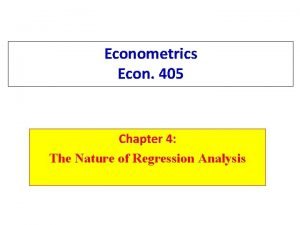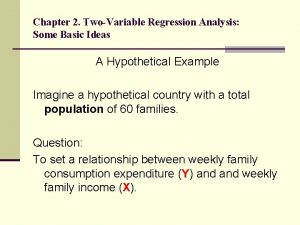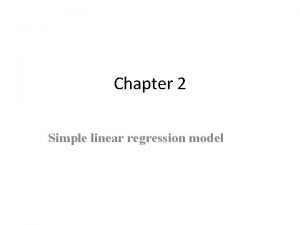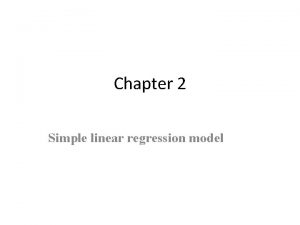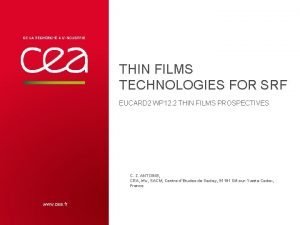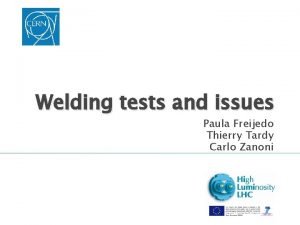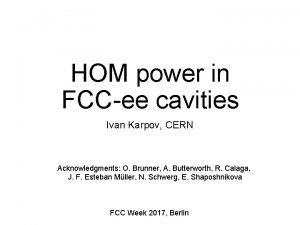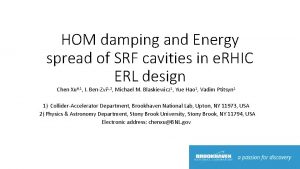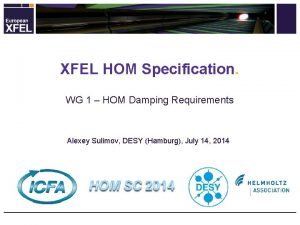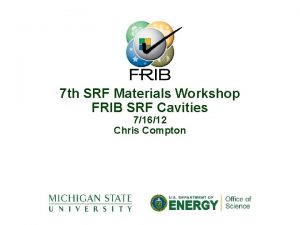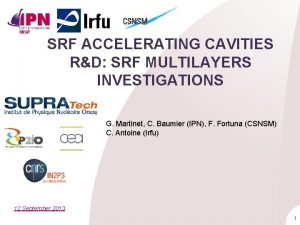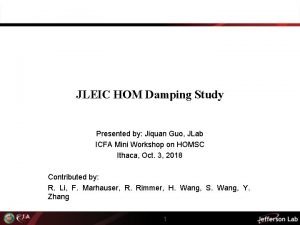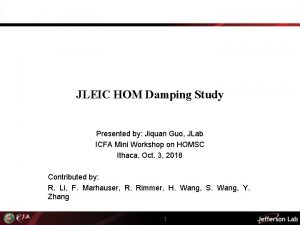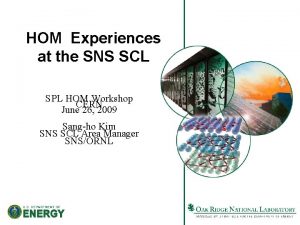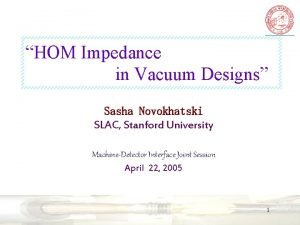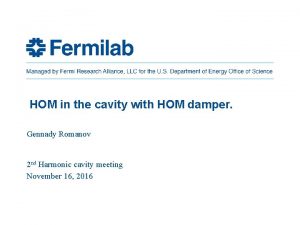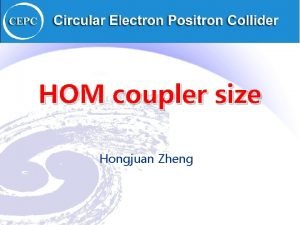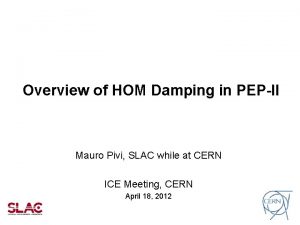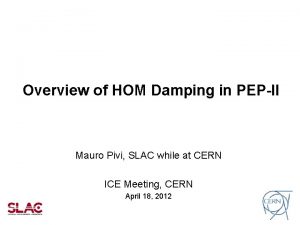Study on HOM Damping Effects in SRF Cavities








![BESSY VSR 1. 5 GHz SRF Cavity Bunch Current [ m. A ] Bunch BESSY VSR 1. 5 GHz SRF Cavity Bunch Current [ m. A ] Bunch](https://slidetodoc.com/presentation_image/341fb4e7a622ee9df160524f56863ed4/image-9.jpg)


![BESSY VSR 1. 5 GHz SRF Cavity 2. 75 GHz 6. 25 GHz f[GHz] BESSY VSR 1. 5 GHz SRF Cavity 2. 75 GHz 6. 25 GHz f[GHz]](https://slidetodoc.com/presentation_image/341fb4e7a622ee9df160524f56863ed4/image-12.jpg)




- Slides: 16

Study on HOM Damping Effects in SRF Cavities of BESSY VSR Project A. Tsakanian# , H. W. Glock, A. Velez , J. Knobloch Helmholtz-Zentrum Berlin, Albert-Einstein-Str. 15, 12489 Berlin International ICFA Mini-Workshop on High Order Modes in SC Cavities 22 - 24 August 2016 Rostock-Warnemünde, Germany

BESSY II SC Upgrade Ø BESSY II is a 1. 7 Ge. V synchrotron radiation source operating for 20 years in Berlin Ø Core wavelength in the range from Terahertz region to hard X rays SC Upgrade Variable pulse length Storage Ring Ø SRF SYSTEM: 2@1. 5 GHz & 2@1. 75 GHz CHALLANGES • CW operation @ high field levels E=20 MV/m • High beam current (Ib=300 m. A), • Cavity HOMs must be highly damped (CBIs) • Exotic cavity design (damping end-groups) BESSY II Parameters Lattice DBA Circumference 240 m Energy 1. 7 Ge. V Current 300 m. A RF Frequency 500 MHz RF Voltage 1. 5 MV Bunch Length 15 ps Emmitance 6 nm rad 2

BESSY II, SC Upgrade – BESSY VSR Present SC Upgrade G. Wüstefeld et al. „Simultaneous long and short electron bunches in the BESSY II storage ring“ IPAC 2011 15 ps bunch • • • 1. 5 GHz and 1. 75 GHz ---- RF beating (modulate RF focusing) Odd (voltage cancelation, 15 ps bunches) Even (voltage addition, 1. 1 ps) Long Bunch Voltage / MV Voltage: 1. 5 MV @ 0. 5 GHz Voltage / MV BESSY VSR Short Bunch Time [ ns ] Baseline Time [ ns ] BESSY VSR Filling Patterns Extended 3

BESSY VSR 1. 5 GHz SRF Cavity Design Stage 1: Cavity geometry 1. 5 GHz design Base models § Cornell 1. 3 GHz (escaled) § Jlab 1. 497 GHz Big iris diameter for high cell-cell coupling Φ=71. 34 m SRF Specifications fullfilled m HZB optimized model Stage 2: HOM damping Operation problems derived from high field values prevented § Analyze HOM in relation to beam spectrum § Provide strong HOM damping in order to avoid CBIs Courtesy of A. Velez 4

BESSY VSR 1. 5 GHz SRF Cavity Model End-Group Down Stream WG_Tapered – 88 -9195 mm Bm. P Diam. – 110 mm FPC – Coax. diam. : 20 x 49 mm End-Group Up Stream Ø 5 - HOM damping Waveguides Ø Large beampipe radius – better HOM propagation Goal Ø Expected HOM power evolution for BESSY VSR Beams. • HOM load capabilities. • Power flowing thru beampipes 5

BESSY VSR 1. 5 GHz SRF Cavity Ø Num. Tune of FPC to Qext~107 working point FPC inner cyll. position from Bm. P [mm] EG-Up. S EG-Dn. S Ø HOM high damping => Large Beampipes Ø Deeper penetration of fundamental acc. mode into the beampipes. 6

BESSY VSR 1. 5 GHz SRF Cavity Shot Range Wakes W// [ V/p. C ] Kloss= 2. 26 V/p. C Setup Wakefield Solver • 5 x WG ports – 15 mode • FPC port – 10 mode • 2 x Bmp – 40 mode Simulation Consistency Ø Energy loss in all ports ~ 1. 46 µJ < 2. 26 µJ (bunch loss). About 35% of EM energy steel remains in fundamental mode. s / σb Wz [ V/p. C ] Ø Ø The vertical kick of fundamental-power-coupler can be compensated by 180 degree rotation of second 1. 5 GHz Cavity. Ø Horizontal kick is 10 K times smaller than vertical. s / σb 7

BESSY VSR 1. 5 GHz SRF Cavity Long Range Wakes Bunch Gauss 1 n. C, σ = 9 mm Prony-Pisarenko Fit Kloss~2. 266 KV/n. C Energy ~ 2. 266µJ Simulated Prony- Fit Freq. [GHz] Kloss [KV/n. C] Qloaded 1. 500 1. 078 1. 85 e 6 1. 651 0. 068 60 1. 685 0. 042 34 2. 705 0. 049 364 2. 757 0. 62 73 4. 301 0. 070 3. 25 e 3 4. 343 0. 102 201 6. 251 0. 052 1. 1 e 3
![BESSY VSR 1 5 GHz SRF Cavity Bunch Current m A Bunch BESSY VSR 1. 5 GHz SRF Cavity Bunch Current [ m. A ] Bunch](https://slidetodoc.com/presentation_image/341fb4e7a622ee9df160524f56863ed4/image-9.jpg)
BESSY VSR 1. 5 GHz SRF Cavity Bunch Current [ m. A ] Bunch Train - Baseline Bucket Number FF T Spectral weighting of port signal & Power per freq. bins (FFT) ∆f =250 MHz

BESSY VSR 1. 5 GHz SRF Cavity Power Balance of Propagating === Coherent. HOMs ==== Port Baseline Extended Single FPC - 1 , 44. 12 38. 72 26. 47 2, 189. 71 154. 08 93. 00 3, 189. 70 154. 08 93. 00 WGs 4, 297. 71 217. 95 127. 65 5, 297. 71 217. 95 127. 65 6, 289. 96 215. 72 124. 31 Bm. P - 7 , 470. 14 413. 57 127. 19 Bm. P - 8 , 531. 85 406. 03 165. 03 ==== Total = 2310. 89 1818. 10 884. 31 -------Baseline >>> FPC = 44. 12 W, HOMs = 1264. 79 W, Bm. P = 1001. 99 W 1. 91 % , 54. 73 % , 43. 36 % === None-Coherent ==== Baseline >> FPC = 40. 05 W, HOMs = 705. 83 W, Bm. P = 595. 65 W, Total = 1341. 54 W 2. 99 % , 52. 61 % , 44. 40 % Original Data >> FPC = 0. 05 W, HOMs = 1. 12 W, Bm. P = 0. 64 W, Total = 1. 81 W 3. 02 % , 61. 66 % , 35. 32 % Max Power in WG (Baseline) = 381. 83 W Ø About 1. 3 KW RF power should be damped in 5 HOM loads (Broadband & Multimode RF load design) Ø 1 KW flowing out thru beampipes (cavity concatenation issues) Ø Power in FPC need to be analyzed in terms of coax. modes (RF window heating issues ) 10

BESSY VSR 1. 5 GHz SRF Cavity Wakefield Simulation Bunch – 9 mm (~ 21 h) Power Balance - Baseline (Total ~ 2311 W) FPC = 44. 12 W, HOMs = 1264. 79 W, Bm. P = 1001. 99 W 1. 91 % , 54. 73 % , 43. 36 % Ø Max. expected power in each load ~ 400 Watt FPC – Coax. diam. : 49 x 20 mm Model – 2 Tapered WGs: 60 x 88 -91 -95 mm 11
![BESSY VSR 1 5 GHz SRF Cavity 2 75 GHz 6 25 GHz fGHz BESSY VSR 1. 5 GHz SRF Cavity 2. 75 GHz 6. 25 GHz f[GHz]](https://slidetodoc.com/presentation_image/341fb4e7a622ee9df160524f56863ed4/image-12.jpg)
BESSY VSR 1. 5 GHz SRF Cavity 2. 75 GHz 6. 25 GHz f[GHz] TE 10 TE 01 TE 11 TM 11 TE 20 TE 21 TM 21 TE 30 TE 02 TE 12 TM 12 TE 31 TM 31 TE 22 TM 22 1. 75 17. 5654 0. 0001 0. 0000 0. 0000 2. 00 3. 9692 0. 0001 0. 0000 0. 0000 2. 25 0. 3279 0. 0005 0. 0000 0. 0000 2. 50 0. 5653 16. 3865 0. 0001 0. 0000 0. 0000 2. 75 139. 4482 8. 4237 0. 0002 0. 0000 0. 0000 3. 00 2. 5146 0. 4105 6. 7323 0. 1913 0. 0000 0. 0000 Ø 0. 0000 At high frequencies (for example 6. 25 GHz), it is difficult to distinguish the bend effect from 5. 25 1. 8647 0. 0183 0. 0234 5. 2666 0. 0123 0. 0055 2. 6393 0. 0122 2. 8285 0. 0361 0. 0000 coupled mode excitation at cavity 0. 0188 & HOM waveguide connection point (WG – 60 x 88 mm). 0. 0000 6. 00 0. 2217 0. 0485 0. 1854 1. 5223 0. 0328 0. 0051 0. 0315 0. 7723 0. 0105 0. 6730 3. 2767 0. 1159 0. 5661 P>20 W P<5 W Sum=73 W 12

Waveguide Bend Broadband Characteristics Transmission & Reflection Broadband Behavior for TE 10 Mode TE 10 TE 11 TM 11 WG Tapered 60 x 88_91_95 mm 60 x 95 mm Taper 91 -95 Taper 88 -91 TM 12 Incident (TE 10) Port, 60 x 88 mm Rbend=30 mm TE 10 - 6. 25 GHz Rbend=30 mm Ø Ø TE 10 mode couples into different modes after bend: TE 10, TE 11, TM 11…, depending on excitation frequency & the cutoff of each WG mode ! At high frequencies the TE 10 is scattered from the bend into several modes, i. e. acts as mode mixer. At optimized 30 mm inner bending radius the reflection is minimal in broadband frequency sense. 13

Waveguide Bend Broadband Characteristics Bending Radius Optimization for WG-Bend Low Reflection Port modes -18 WG Tapered 60 x 88_91_95 mm TE 10 - 3. 05 GHz Rbend=50 mm Frequency [ GHz ] Ø Low reflection (broadband) from the WG bend is for bending radius = 30 mm or b. R ≥ 100 mm. 14

BESSY VSR 1. 5 GHz SRF Cavity Fundamental-Power-Coupler TE 11 – 5. 7 W TEM – 1. 4 W TE 11 – 2. 85 W Mode 5 – 3. 3 W Total - 44 W Mode Power 1– TEM 8. 07 W 3– TE 11 25. 22 W 5 – TE 6. 18 W Coax Diam. – 42 x 18 mm 7 – TE 3. 49 W Cutoff Frequency 8 – TM 1. 09 W 6. 25 GHz 18 % 57 % 14 % 7. 9 % 2. 5 % FPC-TE 11: 3. 248 GHz Ø About 25 W of HOM power is propagation in FPC as TE 11 mode. Ø FPC RF window heating issues. 15

Summary Ø The technique for calculation of RF power propagation of HOMs excited by the circulating beam in SRF cavities. • • Long Range Wake computation (single bunch). Bunch train - Spectral weighting of port signals. Single Cavity HOM power balance estimation & RF Load Specification (spectrum up to 20 GHz possible). Estimate changes in RF Load capabilities from short bunch ! • • SRF module - 4 x Cavity chain (Concatenation Study) • First test with CST – 9 mm bunch possible ~2 Week. • Cavity cross talk – Do we expect considerable HOM power increase at one of the local loads ? • Confirm HOM load specifications. • Validate Impedance budget. • Tune bellow transitions. This class of simulations are very expensive – time consuming & comp. resource. Available resources for 5 mm(~15 ps) smallest bunch length and long range 20 m (~ 1 Week). For 9 mm ~21 h But smallest VSR bunch is 1. 1 ps~330µm (standart opt. ) !!! Challenging task. Collaborations – HOMs above 20 GHz. Thank You for Your Attention ! 16
